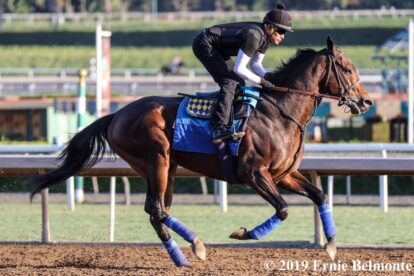When I started this year’s Breeders’ Cup Skinny columns in mid-September, I wrote that it was time to start studying for your final exam of 2019.
If you’re one of those students who skipped class most of the semester and slid through with barely-passing grades, then now is really the time to start cramming. In horseplayer and handicapper terms, the final exam each year is the Breeders’ Cup.
With massive pools and large, evenly-matched fields starring the most talented horses in the world, abundant betting opportunities give bettors the chance to score out on the year. And now that the Breeders’ Cup “Win and You’re In” series is complete, we can digest the final preps while waiting for fields to fully form.
As we wait for the the pre-entries to come out on October 23, let’s go through an important exercise: identifying vulnerable favorites whose defeats can help you build your Breeders’ Cup plays. It really only takes a few nicely-constructed tickets – leveraging a value play or longshot – to make your Breeders’ Cup a winning one.
I’ll highlight three races that I think have vulnerable favorites over these next editions of the Breeders’ Cup Skinny. Later, we’ll dig into the pace scenarios for each race, starting with the Classic.

Evaluating Likely Classic Favorite McKinzie
A few horses in this year’s Classic field will vie for favoritism, but when it’s all said and done, the fact that Bob Baffert trains the multiple Grade 1 winner McKinzie may be enough to make him the bettors’ top choice in the 36th running of the Breeders’ Cup Classic.
I’ve said since mid-September that how you bet the marquee race of the World Championship boils down to whether or not you believe that McKinzie can excel at the race’s 1 1/4-mile distance. He has ran this far on two occasions previously:
- Last year when he finished 12th, losing by 31 lengths in the Breeders’ Cup Classic at Churchill Downs
- Earlier this year in April in the Santa Anita Handicap (G1) when he lost to Gift Box by a nose after leading in the stretch
Can he really get the job done going this long?
Going 1 1/8 miles in his Whitney Stakes (G1) win at the beginning of August, he was dominant; he easily beat Vino Rosso and Yoshida, who he will face again here. He also has the greatest trainer in the modern era priming him, so there are many reasons to back McKinzie, but there are also reasons to stand against him.
His ability to excel at this distance is a major question mark, and his last race (a second in the local Awesome Again Stakes [G1]) wasn’t visually pleasing. Even though he got caught behind a slow pace, and even though jockey Mike Smith decided to take him back at the start and again on the backstretch, McKinzie still didn’t show the usual pep in his step.
He ended up being unable to track down a loose-on-the-lead Mongolian Groom when the real running began. McKinzie also lost late in both the San Pasqual Stakes (G2) and the Santa Anita Handicap (G1) earlier this year while going 1 1/8 miles; that doesn’t bode well for him going farther on this track
The latest defeat cost Smith the mount on McKinzie, who will now pick up Joel Rosario. McKinzie hasn’t known another jockey in a race besides Smith, so Baffert’s gamble to change riders before a $6 million event is intriguing, to say the least.
Rosario is a top-notch jock who won last year’s Classic on Accelerate, so he’s no stranger to the big stage, but his best mounts are usually aboard horses who make one huge run late. Based on his running lines and with Santa Anita Park continuing to benefit early speed, McKinzie will likely need to be forwardly-placed.

Classic Pace Analysis
Will the pace scenario in the Classic work out better for McKinzie than it did in the Awesome Again?
Right now, Mongolian Groom is a likely early leader, but he may take pressure from War of Will, who is likely to falter when the real running begins. Trainer Mark Casse really has no choice but to hope that Tyler Gaffalione gets the Preakness Stakes (G1) winner involved early, which would make the pace of the Classic more honest than the Awesome Again. That should also soften up Mongolian Groom, who won as a 25/1 longshot after only nibbling the board in other graded stakes efforts this year.
McKinzie should be able to sit off of those two, and if War of Will softens Mongolian Groom at all, then McKinzie should be able to take command coming into the stretch.

Vino Rosso was on the lead in the five-horse Jockey Club Gold Cup Stakes (G1), but he will likely want to sit off of the front-runners here, just like he did in his Gold Cup at Santa Anita Stakes (G1) win in May, when he sat fourth early. If Vino Rosso can get that same trip here (even though he was four-wide early last time at Santa Anita), the Todd Pletcher pupil will be very dangerous at a distance that he loves.
All hope was lost for Higher Power when he stumbled from the gate in the Awesome Again, as he is another horse who likes to be forwardly placed. As evidenced by his stalk-and-pounce victory in the Pacific Classic (G1) at this 1 1/4-mile distance, Higher Power’s best trip under Flavien Prat is to sit off of a target. Trainer John Sadler won this race last year with Accelerate and will try to repeat with a horse who likes the distance and should be hanging around late.
Starting the mid-pack cavalry should be the mare Elate, who will try boys for the first time over a distance at which she’s excelled. She’s a perfect 3-0 while going 1 1/4 miles and facing females in the 2017 Alabama Stakes (G1) and the past two Delaware Handicaps (G2). Her Brisnet speed figures at this distance make her competitive against this group, so why not take a shot? I discussed this in detail in a previous Breeders’ Cup Skinny.
The back of the pack will be crowded with horses looking to make one big run, like the Travers Stakes (G1) winner Code of Honor, the Stephen Foster Handicap (G2) victor Seeking the Soul, the 2018 Woodward Stakes (G1) winner Yoshida, the Pennsylvania Derby (G1) upsetter Math Wizard, and the recent Oklahoma Derby (G3) winner Owendale.
Of those looking to gobble up the field late, Code of Honor looms the largest. He did as much when he was named the Jockey Club Gold Cup winner over Vino Rosso via disqualification. The Shug McGaughey-trained colt may be the likely second choice in the wagering (and even the possible favorite), but there are a few things that should make you leery of him in this spot.
The 3-year-old will need to ship cross-country for the first time, and when he shipped to Churchill Downs for last year’s Breeders’ Cup Juvenile (G1), he spiked a fever the morning of the race. I know that it’s a bit of a reach, but it’s a small concern that he’ll ship to Santa Anita the week of the race.
More importantly, Code of Honor is a small-framed horse who is still developing physically. His back-to-back 108 Brisnet speed figures at this 1-1/4 mile distance are eye-catching, and he’ll run at this distance for a third straight time, rare in this day and age. He’ll be fit, but the fact that McGaughey was hesitant to commit to the Breeders’ Cup after his Jockey Club Gold Cup victory is also concerning.
Then again, maybe I’m grasping at straws here, since these are all minor concerns.

Verdict: Play Against McKinzie on Top in the Classic
There are better options than McKinzie to win the Classic this year, and there is certainly value to be had in wagering without him. Playing against Baffert is always a risky proposition, but if you do beat him, the massive pools will fill your wallet.
Right now, I’m leaning towards playing Vino Rosso to win. He has shown a liking for the track and the distance, and he seems to be coming of age; he’s a late-blooming son of Curlin, a sire who has been known to produce horses who age well, like a fine wine. Vino Rosso has the running style to be near the early pace, which will help on a likely speed-favoring track, and has shown a late kick at this track that McKinzie hasn’t displayed.

Still, McKinzie may be able to gut it out based on his class to hit the board. A number of others can fill out your exotics. Code of Honor is as honest as they come; you can’t get beat by using him in the second and third slots. Higher Power can hold on for a piece. Yoshida, who was a late-charging fourth in the Classic last year, can also get up for a piece. These should be included in trifecta plays. I’ll probably have to throw Elate into a few exotic wagers, too, in case she’s able to grind away top-three finish.
All of my wagering strategies and ticket constructions will be in the Racing Dudes’ Inside Track to the 2019 Wagering Guide, available for pre-order now. The first edition will be released after entries are drawn on October 23, so get on board with the Dudes for this year’s Breeders’ Cup!
In the meantime, feel free to follow me on Twitter @SaratogaSlim for updates on when my next Breeders’ Cup Skinny articles will come out.











